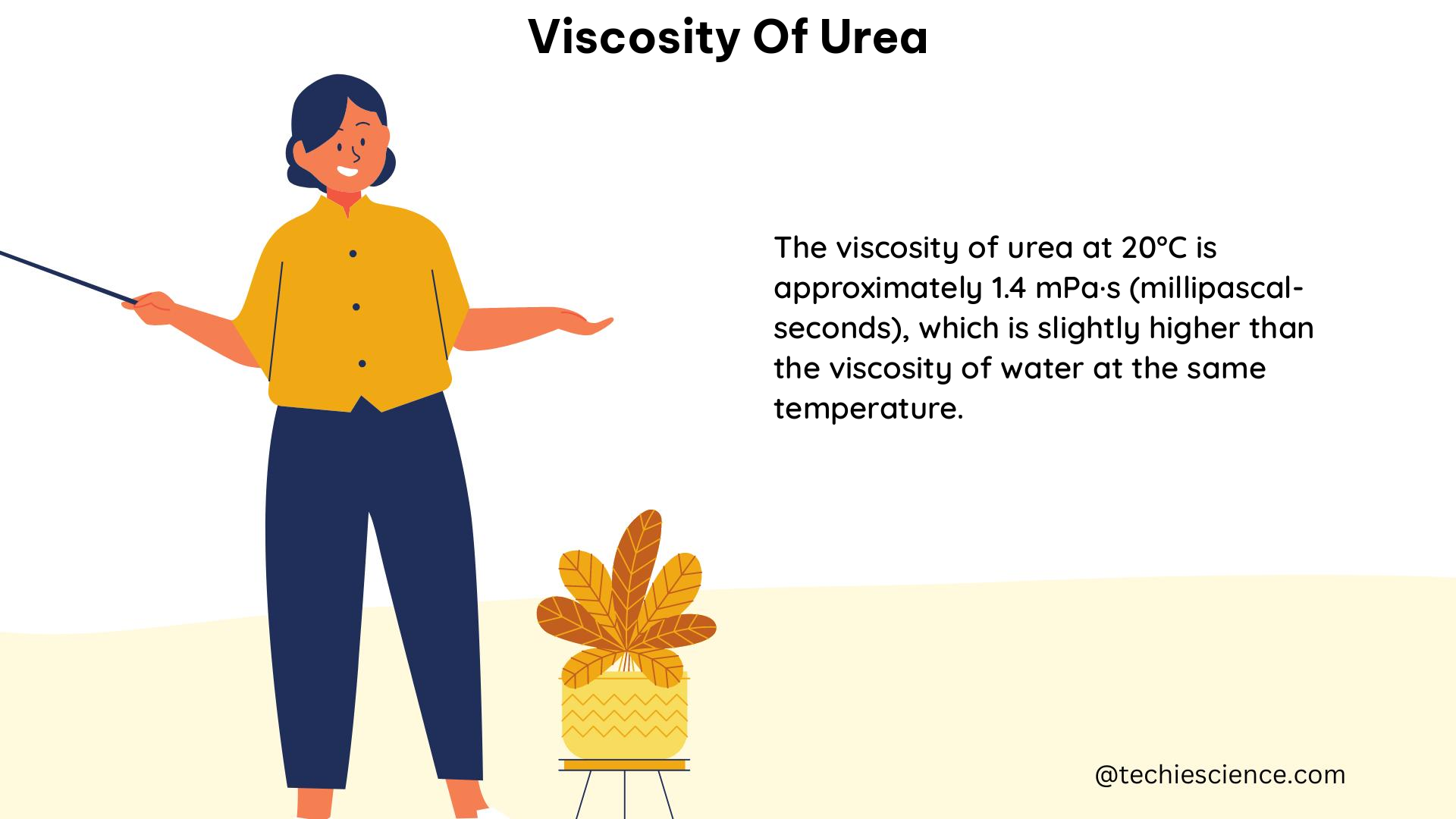The viscosity of urea solutions is a critical physical property that has been extensively studied in various research works. This comprehensive guide will delve into the intricacies of urea viscosity, providing a detailed understanding of the factors that influence it, the experimental techniques used to measure it, and the practical applications of this knowledge.
Understanding Urea Viscosity
Urea, a simple organic compound with the chemical formula CO(NH2)2, is widely used in various industries, from agriculture to pharmaceuticals. The viscosity of urea solutions is a crucial parameter that determines the flow behavior of these solutions, which is essential for various applications.
Factors Affecting Urea Viscosity
The viscosity of urea solutions is primarily influenced by the following factors:
-
Urea Concentration: The viscosity of urea solutions increases with the concentration of urea. As the urea content increases, the intermolecular interactions between urea molecules and water molecules become more complex, leading to a higher resistance to flow.
-
Temperature: The viscosity of urea solutions is inversely proportional to temperature. As the temperature increases, the kinetic energy of the molecules increases, resulting in a decrease in viscosity.
-
Presence of Other Ions: The presence of other ions in the urea solution can also affect its viscosity. The addition of salts or other solutes can alter the intermolecular interactions, leading to changes in the solution’s viscosity.
Theoretical Considerations
The viscosity of a fluid, including urea solutions, is a measure of its resistance to flow. This resistance is caused by the internal friction between the fluid’s molecules, which can be described by the following physics formula:
Viscosity (η) = Shear Stress (τ) / Shear Rate (γ)
where:
– Viscosity (η) is the measure of a fluid’s resistance to flow, typically expressed in Pascal-seconds (Pa·s) or centipoise (cP).
– Shear Stress (τ) is the force per unit area acting on the fluid, causing it to flow, measured in Pascals (Pa).
– Shear Rate (γ) is the rate of change of the fluid’s velocity gradient, measured in inverse seconds (s^-1).
Understanding this relationship is crucial for predicting the flow behavior of urea solutions and designing efficient processes that involve their handling and transportation.
Experimental Techniques
The viscosity of urea solutions can be measured using various experimental techniques, with the Ubbelohde capillary viscometer being a widely used method. This instrument measures the time it takes for a fixed volume of the solution to flow through a calibrated capillary tube under the influence of gravity. By controlling the temperature of the viscometer, accurate viscosity measurements can be obtained.
Other techniques, such as rotational viscometers and falling ball viscometers, can also be employed to measure the viscosity of urea solutions, depending on the specific requirements of the application.
Practical Applications of Urea Viscosity

The knowledge of urea viscosity has numerous practical applications in various industries:
-
Agriculture: Urea is a widely used fertilizer, and understanding its viscosity is crucial for the efficient application and distribution of urea-based products.
-
Pharmaceuticals: Urea is used in various pharmaceutical formulations, and its viscosity plays a role in the development of stable and effective drug delivery systems.
-
Chemical Processing: Urea is an important feedstock in the production of various chemicals, and its viscosity affects the efficiency of chemical processes, such as heat transfer and mass transfer.
-
Automotive Industry: Urea-based solutions, such as AdBlue, are used in selective catalytic reduction (SCR) systems to reduce nitrogen oxide emissions in diesel engines. The viscosity of these solutions is crucial for the proper functioning of the SCR system.
-
Environmental Applications: Urea-based solutions are used in water treatment processes, and their viscosity affects the efficiency of these processes.
Numerical Examples
Let’s consider a few numerical examples to illustrate the practical application of urea viscosity:
- Shear Rate and Shear Stress Calculation:
- A fluid with a viscosity of 0.5 Pa·s is flowing through a pipe with a diameter of 2 cm at a rate of 10 cm/s.
- Shear Rate (γ) = (2 × Velocity) / Diameter = (2 × 10 cm/s) / 2 cm = 10 s^-1
-
Shear Stress (τ) = Viscosity × Shear Rate = 0.5 Pa·s × 10 s^-1 = 5 Pa
-
Viscosity Variation with Urea Concentration:
- Urea Concentration: 0 M, Viscosity: 1.002 mPa·s
- Urea Concentration: 2 M, Viscosity: 1.010 mPa·s
- Urea Concentration: 4 M, Viscosity: 1.040 mPa·s
- Urea Concentration: 6 M, Viscosity: 1.100 mPa·s
- Urea Concentration: 8 M, Viscosity: 1.200 mPa·s
These examples demonstrate how the viscosity of urea solutions varies with the concentration of urea and how the shear rate and shear stress can be calculated based on the viscosity and flow characteristics.
Conclusion
The viscosity of urea solutions is a critical physical property that has a significant impact on various industries and applications. By understanding the factors that influence urea viscosity, the experimental techniques used to measure it, and the practical applications of this knowledge, researchers and engineers can optimize processes, develop better products, and contribute to the advancement of various fields.
References
- Urea-Water-Solution Properties: Density, Viscosity, and Surface Tension in an Under-Saturated Solution. (2016). Retrieved from https://onlinelibrary.wiley.com/doi/10.1155/2016/2658747
- Viscosity and Density of Aqueous Solutions of Urea and Guanidine Hydrochloride. (2023). Retrieved from https://www.jbc.org/article/S0021-9258%2818%2996519-1/pdf
- Urea-Water-Solution Properties: Density, Viscosity, and Surface Tension in an Under-Saturated Solution. (2016). Retrieved from https://www.researchgate.net/publication/310863204_Urea-Water-Solution_Properties_Density_Viscosity_and_Surface_Tension_in_an_Under-Saturated_Solution
- Effect of Urea Concentration on the Viscosity and Thermal Stability of Urea-Water Solutions. (2016). Retrieved from https://adsabs.harvard.edu/full/1952AuSRA…5..555W
- The Viscosity of Urea Solutions of Keratin. (1952). Retrieved from https://www.proquest.com/scholarly-journals/urea-water-solution-properties-density-viscosity/docview/2387456865/se-2

The lambdageeks.com Core SME Team is a group of experienced subject matter experts from diverse scientific and technical fields including Physics, Chemistry, Technology,Electronics & Electrical Engineering, Automotive, Mechanical Engineering. Our team collaborates to create high-quality, well-researched articles on a wide range of science and technology topics for the lambdageeks.com website.
All Our Senior SME are having more than 7 Years of experience in the respective fields . They are either Working Industry Professionals or assocaited With different Universities. Refer Our Authors Page to get to know About our Core SMEs.